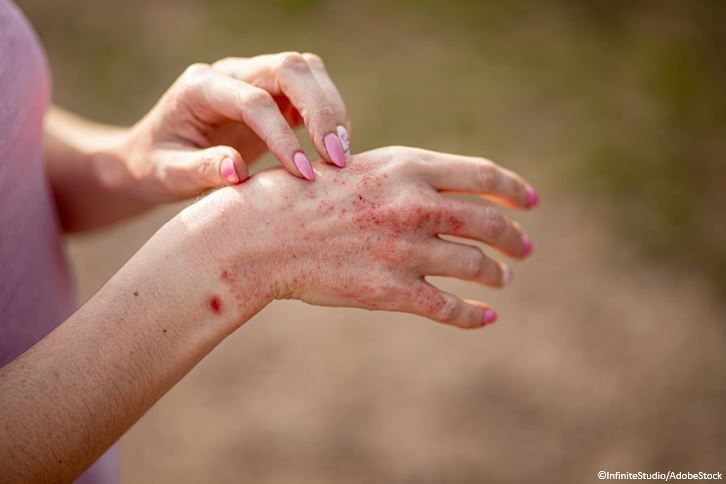Roflumilast Cream 0.15% Leads to Consistent Improvements in Atopic Dermatitis Across Diverse Skin Types
Roflumilast cream 0.15% was associated with consistent and meaningful improvements in AD clearance and itch reduction, according to new data.
©InfiniteStudio/AdobeStock

Roflumilast cream (Zorvye®, Arcutis Biotherapeutics) 0.15% led to consistent and meaningful improvements in signs and symptoms of atopic dermatitis (AD) across an ethnically and racially diverse cohort that included a range of Fitzpatrick skin types, according to new research.1
The results are from a pooled subgroup analysis of the INTEGUMENT-1 and -2 phase 3 clinical trials of roflumilast cream 0.15% and will be presented at the European Academy of Dermatology & Venereology Congress, held September 25 to 28, 2024, in Amsterdam, according to an Arcutis new release.1 The data were also published online September 18, 2024, in JAMA Dermatology.2
Roflumilast cream 0.15% is a next-generation topical phosphodiesterase 4 (PDE4) inhibitor indicated for the topical treatment of mild-to-moderate AD in adults and children as young as age 6 years.1
The identical, parallel group, double-blind, vehicle-controlled, randomized INTEGUMENT-1 and INTEGUMENT-2 studies examined the safety and efficacy of once-daily roflumilast in persons with mild-to-moderate AD, as assessed by the Validated Investigator Global Assessment for Atopic Dermatitis (vIGA-AD; 5-point scale ranging from 0 [clear] to 4 [severe]). The cohort totaled 1337 participants who received either roflumilast or vehicle cream once a day for 4 weeks.2
At week 4, higher percentages of vIGA-AD success – defined for the purpose of the study as a score of 0 or 1 plus a 2-grade improvement from baseline – were observed among roflumilast-treated participants compared to vehicle-treated participants regardless of race (White: 32.3% vs. 13.3%; Black: 25.8% vs 11.5%; Asian: 33.7% vs 21.8%; Others: 33.2% vs 13.7%), ethnicity (Hispanic or Latino: 32.9% vs 16.5%; non-Hispanic or Latino: 31.1% vs 13.8%), or Fitzpatrick score (I–III: 33.0% vs 13.4%; IV–VI: 29.2% vs 14.8%). The Fitzpatrick skin type is a scale of I to VI classifying skin by its reaction to exposure to sunlight, with type I being pale white skin that always burns and does not tan to type VI which is dark brown or black skin that never burns and always tans darkly, according to Arcutis.1
“Given that the clinical presentation of AD may differ among patients by race, ethnicity, and Fitzpatrick skin type, it is reassuring to see the consistency of efficacy, safety, and tolerability of a treatment across these various subgroups,” INTEGUMENT coauthor Vimal H. Prajapati MD, clinical associate professor at the University of Calgary, Alberta, Canada, said in the September 24, 2024, press release.1
Investigators also found that roflumilast-treated participants achieved a greater improvement in itch as measured by reductions in Worst Itch-Numeric Rating Scale (WI-NRS) success at week 4 compared to vehicle-treated participants. WI-NRS success was defined as a 4-point or greater improvement at week 4 in persons aged 12 years and older with baseline WI-NRS score of 4 or greater. These results were consistent across subgroups regardless of race (White: 33.5% vs 16.5%; Black: 30.6% vs 21.0%; Asian: 25.4% vs 7.9%; Others: 34.3% vs 22.7%), ethnicity (Hispanic or Latino: 37.4% vs 30.5%; non-Hispanic or Latino: 30.9% vs 13.8%), or Fitzpatrick score (I–III: 35.5% vs 15.0%; IV–VI: 27.3% vs 18.2%). Researchers noted similar results for additional endpoints including achievement of vIGA-AD score of 0 (clear) or 1 (almost clear) and 75% improvement in the Eczema Area and Severity Index (EASI-75).1
The incidence of treatment emergent adverse events (TEAEs) was low in both roflumilast- and vehicle-treated participants. Those who received roflumilast were noted as having consistent TEAE incidence rates across the various subgroups, with common reactions being nausea, headaches, pain at application regions, diarrhea, and vomiting.1
“ZORYVE cream 0.15% consistently achieved meaningful and significant improvements in disease clearance and itch reduction, in all subgroups. This analysis can give confidence to clinicians that ZORYVE provides effective and well-tolerated relief of atopic dermatitis signs and symptoms across individuals with diverse skin types,” Prajapati added in the release.1
References:
- New data shows ZORYVE® (roflumilast) cream 0.15% provided consistent improvement of atopic dermatitis in individuals with diverse skin types. Arcutis Biotherapeutics. News release. September 24, 2024. Accessed September 25, 2024. https://investors.arcutis.com/news-releases/news-release-details/new-data-shows-zoryver-roflumilast-cream-015-provided-consistent
- Simpson EL, Eichenfield LF, Prajapati VH, et al. Roflumilast cream, 0.15%, for atopic dermatitis in adults and children: INTEGUMENT-1 and INTEGUMENT-2 randomized clinical trials. JAMA Dermatol. Published online September 18, 2024. doi:10.1001/jamadermatol.2024.3121